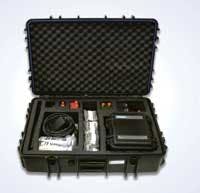Cost-Efficient On-Site Check Metering Made Easy
By Brian Roughan
Portable check-metering kit enables verification of virtually any flowmeter regardless of technology and brand.
When a flowmeter in operation has to be verified, it usually must be uninstalled and transported to a facility for the necessary verification or check-metering. With an on-site verification device, though, this task is made much faster, easier and at a fraction of the cost. When using the right meter, the result can even be as accurate as any off-site verification.
In many process plants in the water & wastewater industry, flowmeters are installed to ensure efficient operation. They’re located in strategic positions where they feed control systems with vital flow rate information to be used as a base for adding or dosing chemicals, measuring water consumption or measuring the installation’s efficiency. Optimal performance is required to secure growth and sustainability so, if an application isn’t performing at its best, it can be adjusted accordingly. This can be the difference between making and losing money. And with the quantity of water going through a large distribution pipe carrying, say, purified water it can amount to a lot of money if a leak, for instance, goes undetected.
Off-site vs. on-site
For these plants to operate efficiently, the plant manager needs to be certain that each flowmeter is operating 100% correct. Upon delivery, meters are usually calibrated and therefore, the operator can be sure they measure correctly. But, if the flowmeter operates under very harsh conditions, if it has been running for hours on end or if the plant operator simply questions a meter’s performance, it can be necessary to check that the meter is still running at 100%. Doing this can be time-consuming and difficult since it often means the equipment must be removed from its location and sent to a factory for testing. Such an operation requires a plant shutdown to uninstall the device, which means lost production time, hours of hard work and, ultimately, loss of money.
In a situation where it’s time-consuming and expensive to uninstall a meter, it can therefore be very beneficial instead to perform an on-site verification of the flowmeter. In such cases, a portable measurement device is used to verify performance and accuracy of the flow meter.
This allows for the verification to take place while the meter is in operation, which is clearly a benefit for the plant operator because a temporary shut-down becomes unnecessary. If such a verification process has to prove itself useful to the customer, however, it has to offer the same benefits as an off-site verification. This means it has to be just as accurate and reliable.
Ultrasonic flow technology
Among the various options typically used for reliable verification today, one product is of particular relevance to the water & wastewater industry: the Sitrans FUP1010 clamp-on check-metering kit from Siemens. Since the meter is based on an ultrasonic flow measurement principle, it has several functionalities with which other flow technologies have difficulties competing.
First of all, it can be used to measure practically all conductive or non-conductive clean or moderately aerated liquids or liquids with suspended solids. This basic feature makes it possible to verify or check the performance of existing meters at any given water & wastewater plant measuring, for instance, raw sewage, effluent or freshwater. Other application areas include temporary leak detection in large intake or distribution pipes in the irrigation industry.
Accuracy is typically around 0.5-1% and repeatability is on the better side of 0.015% making it deal for verifying high precision measurement tasks such as chlorine feed to drinking water.
Dual mode of operation
One of the most significant advantages, though, is that the meter has two modes of operation: transit-time and doppler. Transit-time operation is the preferred mode for relatively homogeneous liquids because the ultrasonic transit-time pulses require a trouble-free passage of the pipe in order to deliver a signal that can be processed. If this requirement is met, accuracy can be up to 0.5% of the flow. Homogeneous liquids are found in primary sludge, mixed liquor or drinking water applications.
Doppler operation, on the other hand, relies on solids or debris in the liquid to offer a precise signal and, hence, is the preferred measurement method for liquids with extensive suspended solids or aeration. Such conditions are typically relevant for measuring thickened and digested sludge. Accuracy with doppler mode is usually up to 1% of the flow.
The system can be set up to automatically switch from one mode of operation to the other as conditions change, eliminating the need to alternate between meters.
As the above examples illustrate, the dualmode capability enables an operator to use the check-meter on almost any application at a water & wastewater plant because its operation can be adjusted and optimized to the specific measurement tasks regardless of aeration and solid percentages. It enables verification of any brand or type of flowmeter based on traditional flow measurement principles including electromagnetic, ultrasonic, orifice or rotary piston technologies.
Portability ensures versatility
The last factor adding to versatility of this particular check-meter is its portability. The kit is battery-powered and comes with a selection of transducers that fit the most common pipe sizes and types within the industry. Since the kit is of the clamp-on meter type, it utilizes external transducers that can quickly and easily be installed on the outside of the pipe. This allows the meter to be transported from one installation to another facilitating the performance of surveys and monitoring of temporary or permanent flowmeter installations.
Conclusion
Using an on-site clamp-on ultrasonic checkmeter to verify performance of existing meters has several benefits for plant operators and managers in the water & wastewater industry. The most persuasive one, however, is that it offers an inexpensive and easy way of verification without having to perform a costly and time-consuming off-site verification.
Author’s Note:
Brian Roughan is senior product manager at the CoC Ultrasonic Flow department of Siemens Energy & Automation’s Process Instrumentation Business Unit. CoC Ultrasonic Flow was part of Controlotron, of Hauppage, New York, USA, acquired by Siemens in 2006. Contact: 631-231-3600 x277, [email protected] or www.siemens.com/processinstrumentation



